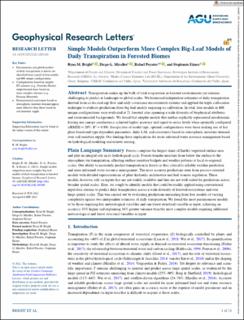| dc.contributor.author | Bright, Ryan M. | |
| dc.contributor.author | Miralles, Diego G. | |
| dc.contributor.author | Poyatos, Rafael | |
| dc.contributor.author | Eisner, Stephanie | |
| dc.date.accessioned | 2022-11-07T10:26:09Z | |
| dc.date.available | 2022-11-07T10:26:09Z | |
| dc.date.created | 2022-10-25T17:49:56Z | |
| dc.date.issued | 2022-09-12 | |
| dc.identifier.citation | Geophysical Research Letters. 2022, 49 (18), 1-13. | en_US |
| dc.identifier.issn | 0094-8276 | |
| dc.identifier.uri | https://hdl.handle.net/11250/3030366 | |
| dc.description.abstract | Transpiration makes up the bulk of total evaporation in forested environments yet remains challenging to predict at landscape-to-global scales. We harnessed independent estimates of daily transpiration derived from co-located sap flow and eddy-covariance measurement systems and applied the triple collocation technique to evaluate predictions from big leaf models requiring no calibration. In total, four models in 608 unique configurations were evaluated at 21 forested sites spanning a wide diversity of biophysical attributes and environmental backgrounds. We found that simpler models that neither explicitly represented aerodynamic forcing nor canopy conductance achieved higher accuracy and signal-to-noise levels when optimally configured (rRMSE = 20%; R2 = 0.89). Irrespective of model type, optimal configurations were those making use of key plant functional type dependent parameters, daily LAI, and constraints based on atmospheric moisture demand over soil moisture supply. Our findings have implications for more informed water resource management based on hydrological modeling and remote sensing. | en_US |
| dc.language.iso | eng | en_US |
| dc.publisher | American Geophysical Union | en_US |
| dc.rights | Attribution-NonCommercial-NoDerivatives 4.0 Internasjonal | * |
| dc.rights.uri | http://creativecommons.org/licenses/by-nc-nd/4.0/deed.no | * |
| dc.title | Simple Models Outperform More Complex Big-Leaf Models of Daily Transpiration in Forested Biomes | en_US |
| dc.title.alternative | Simple Models Outperform More Complex Big-Leaf Models of Daily Transpiration in Forested Biomes | en_US |
| dc.type | Peer reviewed | en_US |
| dc.type | Journal article | en_US |
| dc.description.version | publishedVersion | en_US |
| dc.rights.holder | © 2022 The Authors | en_US |
| dc.source.pagenumber | 1-13 | en_US |
| dc.source.volume | 49 | en_US |
| dc.source.journal | Geophysical Research Letters | en_US |
| dc.source.issue | 18 | en_US |
| dc.identifier.doi | 10.1029/2022GL100100 | |
| dc.identifier.cristin | 2064984 | |
| dc.relation.project | Norges forskningsråd: 295128 | en_US |
| dc.relation.project | ERC-European Research Council: 715254 | en_US |
| dc.source.articlenumber | e2022GL100100 | en_US |
| cristin.ispublished | true | |
| cristin.fulltext | original | |
| cristin.qualitycode | 2 | |

